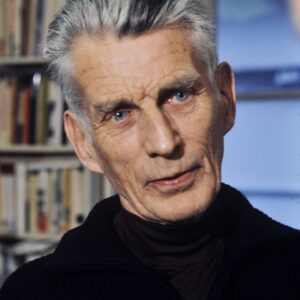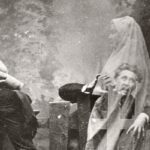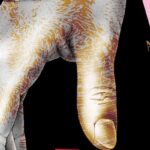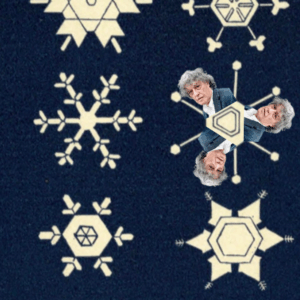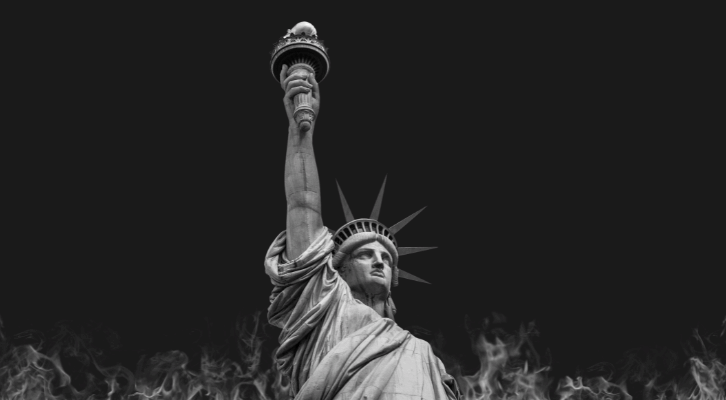
Uncanny Prescience: Revisiting Kafka’s Amerika
Mark Harman Considers the Striking Social Commentary of the Unfinished Novel
Unlike the obsessive protagonists of The Trial and The Castle, who draw us into their labyrinthine thinking, Karl Rossmann, the naive young hero of Kafka’s Amerika or, to use Kafka’s own title, Der Verschollene (“The Missing Person”), bumbles through the strange new world to which he has been banished. Kafka’s intention was, as he acknowledges in an October 1917 diary entry, “to write a Dickens novel, only enhanced by the sharper lights I would have taken from the times and the duller ones I would have found in myself.”
Although The Missing Person has lost none of its resonance, it is still surprisingly neglected in the country in which it is set. In a 2009 New York Times review of my translation of the novel the critic Adam Kirsch summarily rejected the very possibility of any connection between Kafka’s vision and American realities: “Amerika is not America; it is a cipher for Kafka’s dream of a country he never visited.” frYet, while it’s true that Kafka never set foot on these shores, he draws in the novel not only on his imagination, but also on what he knew and intuited about the United States.
Whereas the title Amerika emphasizes the setting, The Missing Person points to the novel’s focus on the travails of a guileless hero struggling to find his footing in a frenetic new world.
While seeds of the novel can be traced back to the 1890’s when Kafka was still in his teens, he wrote it between 1912 and 1914, a period during which he, by day an accident-insurance lawyer at the semi-state Workers Accident Insurance Institute, was advocating for greater safety measures in Bohemian factories. Though notoriously critical of his literary work, he took such pride in his professional articles that he would give his writer friends copies of those precisely worded and persuasively argued pieces on topics such as “Measures for Preventing Accidents from Wood-Planing Machines.” So no wonder that his engagement with the human cost of rapid industrialization in early 20th century Bohemia fed into his depiction in the novel of social conditions in robber-baron America.
Although Kafka refers to his work-in-progress as “Der Verschollene” in a November 1912 letter to his eventual fiancée Felice Bauer, his literary executor Max Brod had no access to that correspondence when he brought out posthumously Kafka’s first novel as Amerika (1927). Brod justified that title by stating that Kafka would refer conversationally to the work as his “American story.” Brod’s German edition was superseded in 1983 by an authoritative German critical edition entitled Der Verschollene (1983), on which I based my translation and which Schocken Books published under the double-barreled title Amerika: The Missing Person. Whereas the title Amerika emphasizes the setting, The Missing Person points to the novel’s focus on the travails of a guileless hero struggling to find his footing in a frenetic new world.
The novel opens as the teenage Karl Rossmann, whose parents shipped him off to America for fathering a child when he was seduced by the family’s thirty-five-year-old cook, arrives on a steamer in New York harbor and sees the Statue of Liberty holding not the emblematic torch but rather a sword. Before disembarking, Karl is greeted by his immigrant uncle, Edward Jakob, whom the cook had notified of his impending arrival. While enjoying a luxurious new start at the mansion of his immigrant uncle, who has risen to become a business magnate and senator, Karl realizes in a now especially resonant passage that without the assistance of his uncle he would have had to endure the plight of less fortunate immigrants:
Where might he have been obliged to live had he come ashore as a poor little emigrant? And perhaps he wouldn’t even have been admitted to the United States, which was very likely according to his uncle, who was familiar with the immigration laws, and the authorities would have sent him home, completely ignoring the fact that he no longer had a homeland. For one could not hope for pity here in this country, and the things that Karl had read about America in that regard were quite true; here it was only those who were fortunate who truly seemed to enjoy their good fortune among the indifferent faces on all sides.
In this melancholy-comic subversion of a rags-to-riches story Karl’s empathetic musings about those less fortunate immigrants foreshadow his subsequent downhill trajectory. The adolescent protagonist soon finds himself at the mercy of his imperious uncle, who puts his nephew out on the street for missing a midnight curfew, of which poor Karl was quite unaware. Although he subsequently manages to find employment as an elevator boy in a gigantic hotel, he is again banished for a minor, and under the circumstances understandable, infraction, one of a series of misadventures in this picaresque American odyssey.
Brod recalls that Kafka, who was reading up about America, would speak with special enthusiasm about a travelogue, Amerika: Heute und Morgen [1912] (“America: Today and Tomorrow”), by Arthur Holitscher, a Hungarian-Jewish essayist, novelist and playwright. Always magpie-like in his borrowings, Kafka artfully reimagines and transposes images and phrases drawn from the Hungarian’s copiously illustrated, often critical, and occasionally high-flown narrative of his travels through North America.
Take, for instance, Holitscher’s hyperbolic indictment of immigration proceedings in New York: “This is Ellis island, the island of torment, of judgment, of misused patience, of naked fate, of the unjust avenger; no Blake could have drawn or sung of the avenging angel who towers over this island in a cloud of fear, whimpering, torture and blasphemy every single day that we spend in this free country.” Recasting that avenging angel as a sword-bearing Statue of Liberty (or “Freiheitsgöttin,” literally “Goddess of Freedom,” a now obsolete German term for the Statue) Kafka modulates Holitscher’s patently sarcastic reference to “this free country” into a suggestive allusion to the “free winds” wafting about the transformed statue.
Being one of those authors who self-edit as they write, Kafka crossed out a revealing passage immediately following that counter-factual description of the iconic Statue: “He looked up at it and dismissed what he had learned about it.” Retaining this almost postmodern sentence might have prompted readers to interpret Karl’s mis-perception in exclusively psychological terms. But Kafka typically distrusted psychological interpretations. In the second paragraph of his most famous story, Die Verwandlung, commonly known as “The Metamorphosis” but more aptly titled “The Transformation,” the impersonal narrator categorically excludes psychological interpretations of Gregor Samsa’s transformation and indeed any commonsensical understanding of that strange event: “It was not a dream.” The reader is thus confronted in the opening passages of both these works with a surreal phenomenon which defies interpretation.
Kafka simply hints at the human cost of the modern emphasis on speed and productivity.
In The Missing Person Kafka draws with a certain comic flair on family lore about four paternal cousins who had emigrated to the United States, including a successful if litigious New York businessman, Otto Kafka, who, as Anthony Northey notes in Kafka’s Relatives, was given to saying that “one must learn to obey before one issues an order,” an expression one can easily imagine on the lips of Karl Rossmann’s uncle. Kafka could not resist poking fun at authority figures, whether in life, in diaries and letters, or in his fiction. For instance, when he has Karl’s uncle boast about the size of his New-York-based business and its “sixty-fifth company of porters,” he is riffing on a detail in the life of his own New York cousin Otto. Otto Kafka’s first job in America was “as a porter with a corset concern,” as Otto states in a September 1918 letter addressed to the assistant attorney-general of the United States, in which he pleads to be released from prison where he was unjustly held on suspicion of being an enemy spy in the then still raging First World War.
Another of Franz’s American cousins, Emil Kafka, worked at the Chicago headquarters of Sears, Roebuck and Company, where, as Arthur Holitscher puts it in his evocative description of the Sears complex, a “metallic din” rose from the typewriters of an “army of girls” typing up orders in a huge open-plan office. Kafka, who told his publisher Kurt Wolff that he wanted to depict the “most modern New York,” sets a scene at the business premises of Karl’s uncle in a vast telegraph hall, where the fingers of the feverishly industrious operators “twitched” at an “inhumanly fast pace.” Here Kafka simply hints at the human cost of the modern emphasis on speed and productivity. At other moments he ratchets up this social criticism, lending certain episodes a Dickensian poignancy, as, for instance, in a tragic story Karl hears from a fellow-immigrant, Therese, about her mother’s fatal fall from haphazardly-built construction scaffolding.
In the last completed chapter, to which Brod gave the offkey title “The Nature Theater of Oklahoma,” Kafka weaves into the narrative some of the existential, mythical, and metaphysical motifs that are familiar to readers of his later work. In the opening lines of this chapter, written in October 1914 along with the still shocking story “In the Penal Colony” while Kafka was taking a break from composing The Trial, Karl is beguiled by a poster proclaiming that “Everyone is welcome” into applying for a position in an enigmatic theatrical organization. Like the rest of a thin stream of applicants, he is greeted on arrival at the hiring site with a great flourish by hundreds of trumpet-blowing women “dressed as angels in white robes with large wings on their backs.”
A seemingly insignificant but in fact telling spelling error in this theater chapter indicates that even in this surreal episode Kafka’s awareness of the prevailing social conditions in America is never far from the surface: The name of the midwestern state is misspelled as “Oklahama,” a slip-up no doubt prompted by an identical misspelling in Holitscher, who caustically captions the picture of a lynching: “An Idyll in Oklahama.” Having been unjustly fired several times, Karl has grown wary of disclosing his name. So when an official of the all-embracing but possibly foreboding theatrical organization asks him for his name, he answers “Negro. . . the nickname from his last few positions.” Kafka’s use of that word was carefully considered: At first, he had Karl reply “Leo,” but after finishing that section he went back and crossed out “Leo,” replacing it nine times with “Negro.”
Kafka’s affinity with Black people arose at least in part from his sense of himself as a Jew in an increasingly hostile Central European environment. In a letter to his first Czech translator, and, briefly, lover, Milena Jesenská, in August 1920 he claims that as far as Europeans are concerned both he and her Jewish husband “have the same Negro face.” This sense of an affinity between Jews and Blacks may have it origins, as Sander Gilman suggests in his study, Franz Kafka: The Jewish Patient, in an originally anti-Semitic trope of Jews’ supposed “blackness.” Some three months later, in another letter to Milena, Kafka describes how during anti-Semitic riots in Prague he looked out the window and saw “mounted police, gendarmes with fixed bayonets, a screaming mob dispersing, and up here in the window the unsavory shame of living under constant protection.” He also mentions having recently overheard someone calling the Jews a “mangy race” and ponders whether it isn’t natural “to leave a place where one is so hated?”
The fate of Karl, now known as Negro, remains murky. Though the hiring process turns out to be a bureaucratic obstacle course, he is finally taken on not as the artist a welcoming angel saw in him nor as the engineer he impulsively claims to be, but rather as a technician. Kafka leaves us with ambiguous images of the now “carefree” Karl traveling with a theatrical troupe through a fantastical depiction of the Rockies, where “broad mountain rivers swept forward in great waves over the craggy base, pushing along thousands of small foamy waves, plunging under the bridges over which the train passed, and coming so close that the breath of their chill makes one’s face quiver.”
Could Karl, who early in the novel plays the piano stirringly and imagines that his performance “might directly affect his situation in America,” find in this flamboyant artistic community a lasting refuge? Or does the breath of the chill foreshadow a grim fate for our engaging, if hapless, hero?
Mark Harman
Mark Harman is Professor Emeritus of German and English at Elizabethtown College. His award-winning translations include Franz Kafka’s Amerika: The Missing Person and The Castle and Selected Stories, as well as Herman Hesse’s Soul of the Age: Selected Letters and Rainer Maria Rilke’s Letters to a Young Poet.









